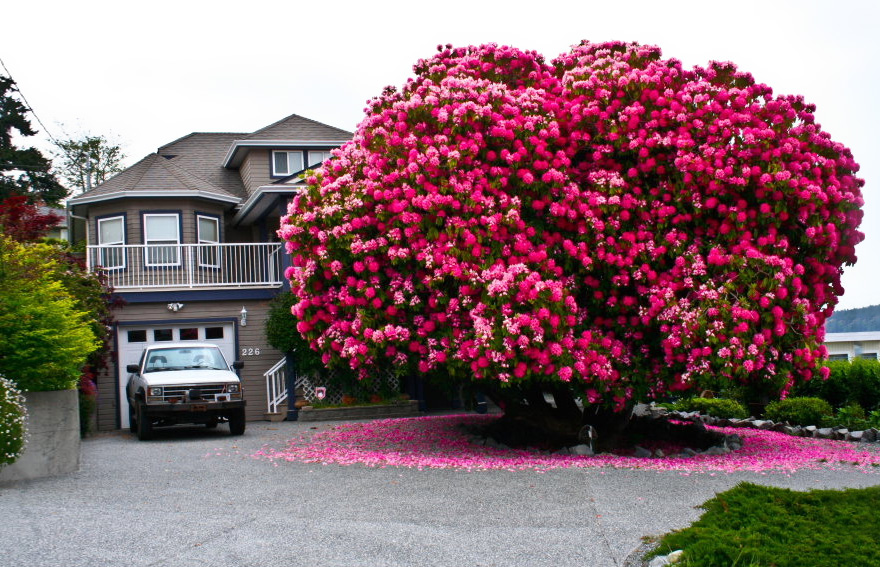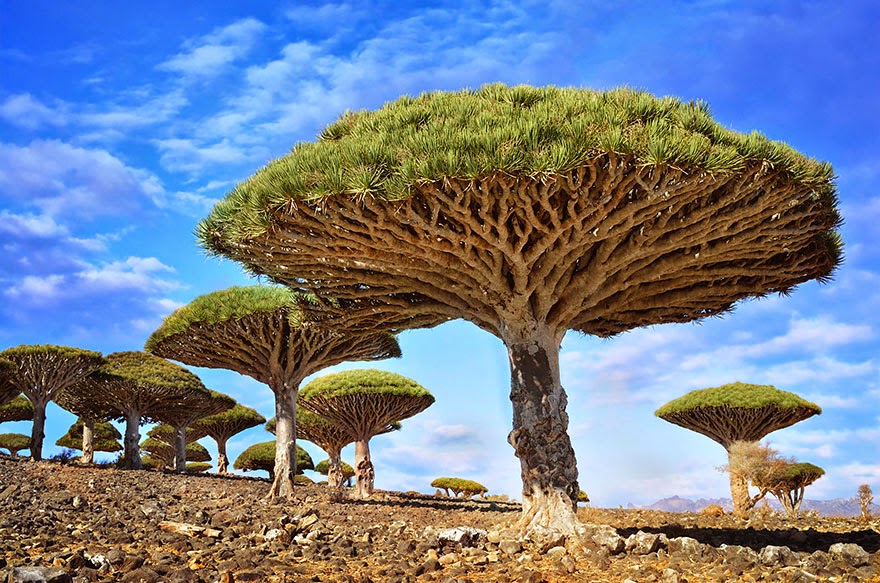Travel talks: Magnifico Trees....
Tengah travel mode ni.
Do you love trees? the whole nature flora fauna kinda thing??
You see my mum is top most fan of trees and she loves loves all about nature.
She used to tell me & my siblings when we were small that her ideal vacay would be in the middle of forest with beautiful trees and her in an astronaut suit (cos nyamuk wont bite!)
(ok mama someday we will grant your wish ok?)
But Me?.. Actually my love for nature is so so lah.. cos Malaysia ni full of hutan .. messy and too green.. and err banyak nyamuk and insects. (macam pic kat atas) Obvious kan im no outdoor girl?
I never knew why my mum's obsession on trees was until i stumbled across this lovely post which id love to share with you guyss...
Suddenly i was looking at these magnificent trees that took my breath away. Ok mum, i have changed my opinion on trees; now we can go to your weird forest vacay together ok?
Trees are one beautiful gifts of god. We dont realise it but let me count the ways; trees change carbon dioxide into the oxygen we breathe, and thus provide shelter for countless creatures (from smallest critters to monkeys and serpents). There are many reasons for which we should all be tree-hugging hippies, but these amazing beautiful trees are simply gorgeous creations of God. (forget about the small trees at the Wisteria is a vine, Rhododendrons are shrubs, and bamboo technically belongs to the grass family).
So scroll more to see these lovelies.. (dont forget once you step outside, when you take a breath of fresh air, hug the nearest tree and say thank you!)1500+ Cengal Tree in Malaysia Forest(image above)
Neobalanocarpus (the scientific name) for our famous Cengal Tree. The single species, Neobalanocarpus heimii, is atropical hardwood tree which grown for over 1000+ years in Malaysia deepest jungle. The tree grows over 60 m (197 ft) tall and considered to be the number one heavy hardwood of Malaysia and export of logs is prohibited due to its scarcity.
This huge 125-year-oldold rhododendron is technically not a tree – most are considered to be shrubs. Not bad kan for shrubs to be this HUGE? When reddit user posted this magnificent picture of an old rhododendron (from Ancient Greek rhódon “rose” and déndron “tree”), he probably made it the most famous rhododendron ever. Most rhododendrons are considered shrubs, but this one definitely could pass for a tree – it’s over 125 years old! (Image credits: reddit)
At 1,990 square meters (about half an acre), this huge wisteria is the largest of its kind in Japan. These stunning photographs, which look like a glorious late evening sky with dashes of pink and purple, are actually pictures of Japan’s largest wisteria (or wistaria, depending on whom you ask) plant. (im going googoogaga here.. cos im sooo LOVING THE PINK! -- hmm do you think i can grow em here on my yard?)
This plant, located in Ashikaga Flower Park in Japan, is certainly not the largest in the world, but it still comes in at an impressive 1,990 square meters and dates back to around 1870 (the largest, at about 4,000 square meters, is the wisteria vine in Sierra Madre, California). Although wisterias can look like trees, they’re actually vines. Because its vines have the potential to get very heavy, this plant’s entire structure is held up on steel supports, allowing visitors to walk below its canopy and bask in the pink and purple light cast by its beautiful hanging blossoms.(Image credits: y-fu)
Wind-Swept Trees In New ZealandThis plant, located in Ashikaga Flower Park in Japan, is certainly not the largest in the world, but it still comes in at an impressive 1,990 square meters and dates back to around 1870 (the largest, at about 4,000 square meters, is the wisteria vine in Sierra Madre, California). Although wisterias can look like trees, they’re actually vines. Because its vines have the potential to get very heavy, this plant’s entire structure is held up on steel supports, allowing visitors to walk below its canopy and bask in the pink and purple light cast by its beautiful hanging blossoms.(Image credits: y-fu)
These trees on Slope Point, the southern tip of New Zealand, grow at an angle because they’re constantly buffeted by extreme antarctic winds.
As wonderful and useful as our modern technologies are, there are still plenty of places in this world where Mother Nature rules supreme. One such place is Slope Point in New Zealand.
Slope Point is the southernmost tip of New Zealand’s South Island. It lies 4800 km (2982 mi) from the South Pole and 5100 km (3168 mi) from the equator, so it’s regularly exposed to unimaginable weather conditions. The air stream loops that travel over the Southern Ocean uninterrupted for 3200 km (2000 mi) make landfall at Slope Point, making for consistently extreme winds. And yet, even in this uniquely harsh environment, extraordinary beauty can be found.
The extreme winds that batter Slope Point are so strong and consistent that the trees that grow there are molded into strangely and beautifully twisted forms. The trees themselves would not exist there if not for the sheep farmers that live nearby. Although Slope Point itself is almost uninhabited and is only reachable my foot, nearby farmers’ sheep graze there.
The farmers raised small groves of hardy trees to offer their livestock some respite from the strong winds.
Writer Trevor Cree described the area like this: “It is not a wind that will necessarily break and snap at will, although clearly it can, it is its sheer relentlessness, like a gnawing toothache, that never ceases until total submission from the victim is achieved.“ (Image credits: Seabird Nz)
Beautiful Japanese Maple In Portland, OregonAs wonderful and useful as our modern technologies are, there are still plenty of places in this world where Mother Nature rules supreme. One such place is Slope Point in New Zealand.
Slope Point is the southernmost tip of New Zealand’s South Island. It lies 4800 km (2982 mi) from the South Pole and 5100 km (3168 mi) from the equator, so it’s regularly exposed to unimaginable weather conditions. The air stream loops that travel over the Southern Ocean uninterrupted for 3200 km (2000 mi) make landfall at Slope Point, making for consistently extreme winds. And yet, even in this uniquely harsh environment, extraordinary beauty can be found.
The extreme winds that batter Slope Point are so strong and consistent that the trees that grow there are molded into strangely and beautifully twisted forms. The trees themselves would not exist there if not for the sheep farmers that live nearby. Although Slope Point itself is almost uninhabited and is only reachable my foot, nearby farmers’ sheep graze there.
The farmers raised small groves of hardy trees to offer their livestock some respite from the strong winds.
Writer Trevor Cree described the area like this: “It is not a wind that will necessarily break and snap at will, although clearly it can, it is its sheer relentlessness, like a gnawing toothache, that never ceases until total submission from the victim is achieved.“ (Image credits: Seabird Nz)
Image credits: Tom Schwabel
Antarctic Beech Draped In Hanging Moss In Oregon
The antarctic beech is native to Chile and Argentina, though this specimen is from the U.S.’ North Pacific region. (Image credits: Drew Hopper)
Blooming Cherry Trees in Bonn, Germany
This beautiful tunnel of cherry blossoms blooms in Bonn, Germany in April. (Image credits: Adas Meliauskas)
Angel Oak In John’s Island In South Carolina
The Angel Oak in South Carolina stands 66.5 ft (20 m) tall and is estimated to be more than 1400 or 1500 years old. (Image credits: Daniela Duncan)
Flamboyant Tree, Brazil
The flamboyant tree is endemic to Madagascar, but it grows in tropical areas around the world. (Image credits: Salete T Silva)
Dragonblood Trees, Yemen
The dragonblood tree earned its fearsome name due to its crimson red sap, which is used as a dye and was used as a violin varnish, an alchemical ignredient, and a folk remedy for various ailments. (Image credits: Csilla Zelko)
The President, Third-Largest Giant Sequoia Tree In The World, California
President, located in Sequoia National Park in California, stands 241 ft (73m) tall and has a ground circumference of 93 ft (28m). It is the third largest giant sequoia in the world (second if you count its branches in addition to its trunk). (Image credits: Michael Nichols)
Maple Tree Tunnel in Oregon
Image credits: Ian Sane
Rainbow Eucalyptus In Kauai, Hawaii
The rainbow eucalyptus, which grows throughout the South Pacific, is both useful and beautiful. It is prized for both the colorful patches left by its shedding bark and for its pulpwood, which is used to make paper. (Image credits: Christopher Martin)
Jacarandas in Cullinan, South Africa
These beautiful Jacarandas, with their violet flowers, grow in South Africa. (Image credits: Elizabeth Kendall)
Avenue Of Oaks At Dixie Plantation In South Carolina
This avenue of oak trees was planted some time in the 1790s on Dixie Plantation in South Carolina. (Image credits: Lee Sosby)
Baobab Trees In Madagascar
These baobabs in Madagascar are excellent at storing water in their thick trunks to use during droughts. (Image credits:confitalsurf)
The Dark Hedges In Northern Ireland
Image credits: Stephen Emerson
 Ireland’s Dark Hedges were planted in the 18th century. This stunning beech tree tunnel was featured on Game of Thrones as well. The Dark Hedges along Bregagh Road in Northern Ireland turns out that we aren't the only ones who think so – this quaint but picturesque avenue is one of the most-photographed locations in Northern Ireland.
Ireland’s Dark Hedges were planted in the 18th century. This stunning beech tree tunnel was featured on Game of Thrones as well. The Dark Hedges along Bregagh Road in Northern Ireland turns out that we aren't the only ones who think so – this quaint but picturesque avenue is one of the most-photographed locations in Northern Ireland.
Photographers, local and foreign alike, flock to the avenue during every season of the year to capture this unique natural phenomenon in different lighting conditions. Bright sunlight, thick fog, golden sunsets and even snowstorms draw photographers to capture this strange tunnel in all of its glory. It’s also a popular destination for couples taking their wedding photos. The epic tree tunnel even appeared in the critically-acclaimed and widely l0ved Game Of Thrones TV series (Season 2 Episode 1).
The beech trees surrounding this serene avenue were planted in the 18th century by the Stuart family in order to impress visitors on the approach to their home, Gracehill House. Over time, the tree’s upper branches expanded and grew together, forming the picturesque and haunting natural cathedral that we see today.
Photographers love taking picture of this mysterious stand of trees in heavy fog, which is fitting because of a ghostly legend surrounding them. It is said that these beeches are haunted by a “Grey Lady” who wanders the trees at dusk, silently gliding the length of the avenue before disappearing at the end of the trees. (Image credits: Christopher Tait)
Love, Ms Dreamyz




















Comments
Post a Comment